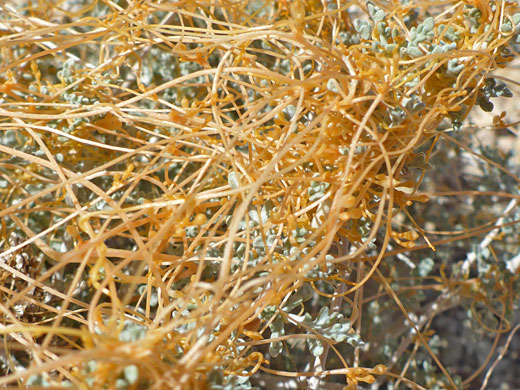Common names:
Desert dodder, small-toothed dodder
Family:
Scientific name:
Cuscuta denticulata
Main flower color:
Range:
Mostly in south California and adjacent desert areas
Height:
Stems are typically 1 to 2 feet in length
Habitat:
Desert flats and slopes, Joshua tree woodland, sagebrush; up to 4,000 feet
Leaves:
None
Season:
May to October
Cuscuta denticulata is the most common of several species of dodder that inhabit the deserts of the Southwest; leafless, parasitic plants, formerly part of their own family, cuscutaceae, but recently transferred to the convolvulaceae.
Stems are brownish-orange, leafless, bearing only tiny scales at alternate intervals, and they are attached to the stems of other plants, not touching the ground. Species are in general only distinguishable by aspects of the flower structure, not always easy to discern.
Desert Dodder produces tiny flowers in late spring, in clusters of up to seven, at intervals along the stem; they have a white, five-lobed corolla, the lobes reflexed, about equal in length to the corolla tube. The shiny, veined, pale yellow calyx is similar in length to the corolla, divided about two thirds to the base into five rounded lobes.
Stems are brownish-orange, leafless, bearing only tiny scales at alternate intervals, and they are attached to the stems of other plants, not touching the ground. Species are in general only distinguishable by aspects of the flower structure, not always easy to discern.
Desert Dodder produces tiny flowers in late spring, in clusters of up to seven, at intervals along the stem; they have a white, five-lobed corolla, the lobes reflexed, about equal in length to the corolla tube. The shiny, veined, pale yellow calyx is similar in length to the corolla, divided about two thirds to the base into five rounded lobes.
All Contents © Copyright The American Southwest | Comments and Questions | Contribute | Site Map

